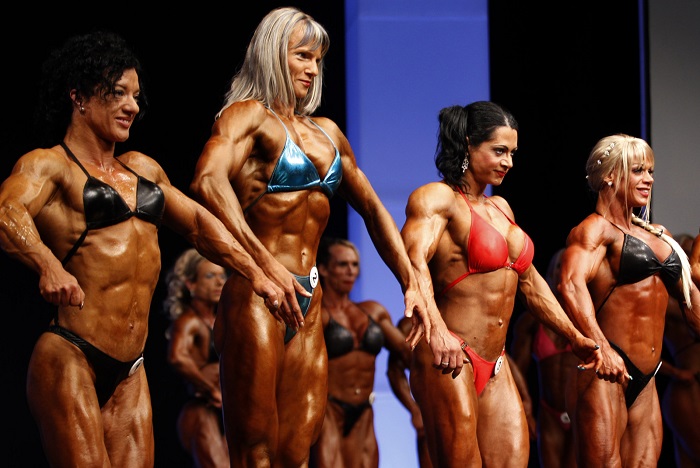
Women’s bodybuilding
Classic Women’s Bodybuilding – nominated by IFBB (now renamed Women Physique ), FBBI and other federations. Participants in the women’s classic bodybuilding division have huge muscle volumes and pronounced relief. As a result of the use of high doses of anabolic steroids, as a rule, all participants show pronounced symptoms of masculinization, including a rough voice, atrophy of the mammary glands (almost all have implants), clitoris hypertrophy, male facial features, etc. Most female athletes have thinning hair on their heads and even male-pattern baldness is observed.
Women Physique
Due to the fact that most of the female bodybuilding division of the IFBB had an extremely repulsive appearance and resembled men, Women’s Physique was formed instead of Women Bodybuilding in 2013. In competitions, they began to give preference to more attractive girls, without obvious masculine features. Muscle volumes have become smaller, high demands are placed on relief, and high doses of androgenic and other anabolic agents are still used, therefore, most athletes have a rough voice, have breast implants (in view of their own atrophy), faces begin to acquire masculine features.

Vumens the physicist includes 2 categories: height up to 163 cm and height above 163 cm.
Other divisions: fitness bikini, body fitness, fitness.
The history of women’s bodybuilding
Women’s bodybuilding as an independent discipline began to develop at the beginning of the twentieth century. In 1965, the first Miss Universe competition was held, but it was hardly a full-fledged bodybuilding competition. Miss Physique ranked alongside Miss America and was more related to the physical attractiveness of women, and less to the musculature.
The first competition to judge women by bodybuilding standards took place in 1978. 1980 was marked by the opening of the first national competition by the National Committee for Physical Development (NPC), in the same year the first female nomination was held in the most important competition among bodybuilders “Mr. Olympia”. Since then, many girls and women have been working with passion to achieve this title of world importance – “Miss Olympia”.
In the mid-1980s, sports became very popular thanks to advertising and, oddly enough, Playboy magazine. One contestant was even disqualified for 1 year for posing for this magazine, but the nude photoshoot was invaluable for this sport, showing amazing results in bodybuilding.
In 2007, women learned how to combine a slim physique with the optimal amount of muscle. Competitors in the “Women’s Bodybuilding” nomination, with all their determination and strength, remain the same women, so attention to their muscle mass is less noticeable than in men’s competitions.

The first record for the most victories in the Miss Olympia competition was set by 6-time winner of the statuette Corey Everson. She was overtaken only by Lenda Murray, who climbed to the top of Olympus 8 times (the last time in 2003).
Trends in the 21st century mark a decline in interest in female bodybuilding, so the financial support of sponsors is also moving down. In recent years, the popularity of fitness competitions has skyrocketed. These changes even pushed four-time Miss Olympia Kim Chizhevski to shed muscle mass and switch to fitness competitions.
